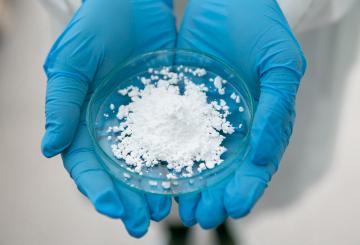Laboratory of Nanohydroxyapatite (LabOFn)

Laboratory of Nanohydroxyapatite (LabOFn) is a group of scientists from the Department of Biotechnology and Bioprocess Engineering and the Laboratory of Biomedical Engineering of the Faculty of Chemical and Process Engineering. We build and develop technologies for synthesizing and applying modified hydroxyapatite nanoparticles.
The team is developing the technology for the precipitation of hydroxyapatite nanoparticles initiated by members of the team and Prof. Tomasz Ciach. Currently, we focus on two aspects of obtaining hydroxyapatite particles: control of particle morphology and size (in batch processes) and functionalization of particles, regardless of their morphology and size, including preparing drug carriers (directly in production processes or post-processing).
In addition to scientific cooperation and expertise in issues related to hydroxyapatite for medical applications, we offer a wide range of hydroxyapatite nano- and microparticles with known properties designed for a wide range of applications. Feel free to contact the manager or team members!
Team members
Head of LabOFn
| Name | Room | Phone | |
|---|---|---|---|
| Michał Wojasiński, dr inż. | 501 | +48 22 234 63 10 | Michal.Wojasinski@pw.edu.pl |
LabOFn members
| Name | Room | Phone | |
|---|---|---|---|
| Tomasz Ciach, prof. dr hab. inż. | 517 | +48 22 234 63 95 | Tomasz.Ciach@pw.edu.pl |
| Paweł Sobieszuk, prof. dr hab. inż. | 504 | +48 22 234 63 19 | Pawel.Sobieszuk@pw.edu.pl |
| Jolanta Czerska-Duszak, mgr inż. | 035 | Jolanta.Duszak@pw.edu.pl | |
| Rafał Podgórski, dr inż. | 168B | Rafal.Podgorski@pw.edu.pl | |
| Kornel Prystupiuk, mgr inż. | 404 | +48 22 234 62 20 | Kornel.Prystupiuk.dokt@pw.edu.pl |
Alumni
| Name |
|---|
| Joanna Latocha, dr inż. |
| Piotr Kowalczyk, dr inż. |
Research infrastructure
- specialized reactors for continuous and batch synthesis and functionalization of hydroxyapatite nano- and microparticles
- equipment for testing the properties of particles in powders and suspensions: size and zeta potential analyzers, scanning electron microscope (cooperation with CEZAMAT), FTIR-ATR spectrometer, equipment for testing the stability and solubility of hydroxyapatite particles and the content of organic components after modification and active substances in the case of carriers medications
- clean-room laboratories for in vitro studies of nanoparticle/cell interactions (e.g., cytotoxicity, cellular uptake, etc.)
- specialized devices for the analysis of samples from in vitro tests: inverted fluorescence microscope, laser scanning confocal microscope, fluorescence spectrometer
Research offer
- synthesis and study of the properties of hydroxyapatite nano- and microparticles with given shapes and functions
- research services in the field of characterizing the properties of nano- and micromaterials in the form of powders or suspensions
- in vitro assessment of the biocompatibility of nano- and micromaterials and medical devices
Current projects
- Development of nanohydroxyapatite/alendronate/lecithin formulation with increased cellular uptake in vitro (BIOTECHMED-1 grant, studies were funded by BIOTECHMED-1 project granted by Warsaw University of Technology under the program Excellence Initiative: Research University (ID-UB), 2020-2023)
- 3D printed polycaprolactone/modified nanohydroxyapatite composite materials with mechanical and osteoinductive properties suitable for bone implants (BIOTECHMED-2 grant, Research was funded by (POB Biotechnology and Biomedical Engineering) of Warsaw University of Technology within the Excellence Initiative: Research University (IDUB) programme, 2021–2023)
- Innovative polymer composites for filling bone defects - INPOLYBOND (POIR.04.01.04-00-0133/15 (NCBR), 2016–2020, the project carried out in a consortium with Biovico sp. z o.o. (project leader))
Our papers
- Mechanically Suitable and Osteoinductive 3D-printed Composite Scaffolds with Hydroxyapatite Nanoparticles Having Diverse Morphologies for Bone Tissue Engineering, M. Wojasiński, R. Podgórski, P. Kowalczyk, J. Latocha, K. Prystupiuk, O. Janowska, S. Gierlotka, M. Staniszewska, T. Ciach, P. Sobieszuk, Journal of Biomedical Materials Research Part B: Applied Biomaterials, 2024, 112(6):e35409. doi:10.1002/jbm.b.35409
- Morphology-controlled precipitation/remodeling of plate and rod-shaped hydroxyapatite nanoparticles, J. Latocha, M. Wojasiński, O. Janowska, U. Chojnacka, S. Gierlotka, T. Ciach, P. Sobieszuk, 2022, e17897. doi:10.1002/aic.e17897
- Scaled-Up 3D-Printed Reactor for Precipitation of Lecithin-Modified Hydroxyapatite Nanoparticles, M. Wojasiński, J. Latocha, P. Liszewska, Ł. Makowski, P. Sobieszuk, T. Ciach, Industrial and Engineering Chemistry Research, 2021, 60(35), 12944-12955. doi:10.1021/acs.iecr.1c02973
- Solution blow spun poly-L-lactic acid/ceramic fibrous composites for bone implant applications, M. Wojasiński, T. Ciach, Chemical and Process Engineering, 2021, 42(3), 275-289. doi:10.24425/cpe.2021.138931
- Impact of morphology-influencing factors in lecithin-based hydroxyapatite precipitation, J. Latocha, M. Wojasiński, P. Sobieszuk, S. Gierlotka, T. Ciach, Ceramics International, 2019, 45(17), 21220-21227. doi:10.1016/j.ceramint.2019.07.103
- Precipitation of hydroxyapatite nanoparticles in 3D-printed reactors, J. Latocha, M. Wojasiński, K. Jurczak, S. Gierlotka, P. Sobieszuk, T. Ciach, Chemical Engineering and Processing - Process Intensification, 2018, 133, 221-233. doi:10.1016/j.cep.2018.10.001
- Synthesis of hydroxyapatite in a continuous reactor: A review, J. Latocha, M. Wojasiński, P. Sobieszuk, T. Ciach, Chemical and Process Engineering - Inżynieria Chemiczna i Procesowa, 2018, 39(3), 281-293. doi:10.24425/122950
- Lecithin-based wet chemical precipitation of hydroxyapatite nanoparticles, M. Wojasiński, E. Duszyńska, T. Ciach, Colloid and Polymer Science, 2015, 293(5), 1561-1568. doi:10.1007/s00396-015-3557-0
Our patents and patent applications
- Polish Patent PL229015-B1: Sposób otrzymywania nanocząstek hydroksyapatytowych. T. Ciach, E. Duszyńska, M. Wojasiński.
- Polish Patent PL244036-B1:: Reaktor do ciągłej syntezy nanocząstek hydroksyapatytu. J. Latocha, M. Wojasiński, P. Sobieszuk, T. Ciach, Ł. Makowski, P. Liszewska.
- Polish Patent Application P.441261 (filling date 24-05-2022): Formulacja nanocząstek fosforanu wapnia o zwiększonym wychwycie komórkowym modyfikowanych lecytyną jako nośnika bisfosfonianów oraz sposób jej wytwarzania. M. Wojasiński, J. Czerska-Duszak, J. Latocha, A. Małolepszy, T. Ciach.
- Polish Patent Application P.440786 (filling date 29-03-2022): Filamenty kompozytowe polimer/modyfikowany materiał ceramiczny, sposób ich wytwarzania i zastosowanie. P. Sobieszuk, O. Janowska, J. Latocha, R. Podgórski, M. Wojasiński, T. Ciach.
Cooperation with business
- R&D project for Merz Aesthetics
